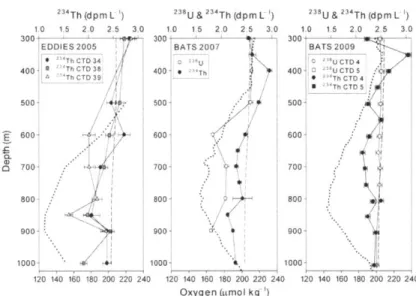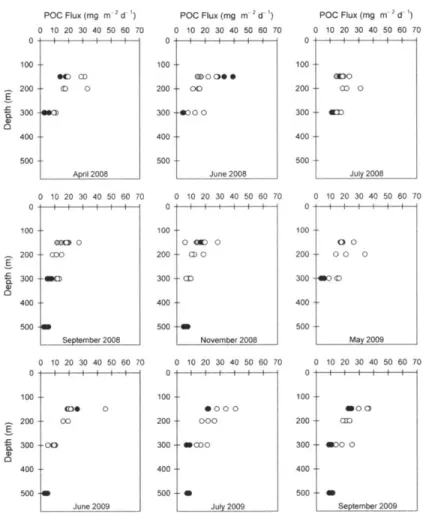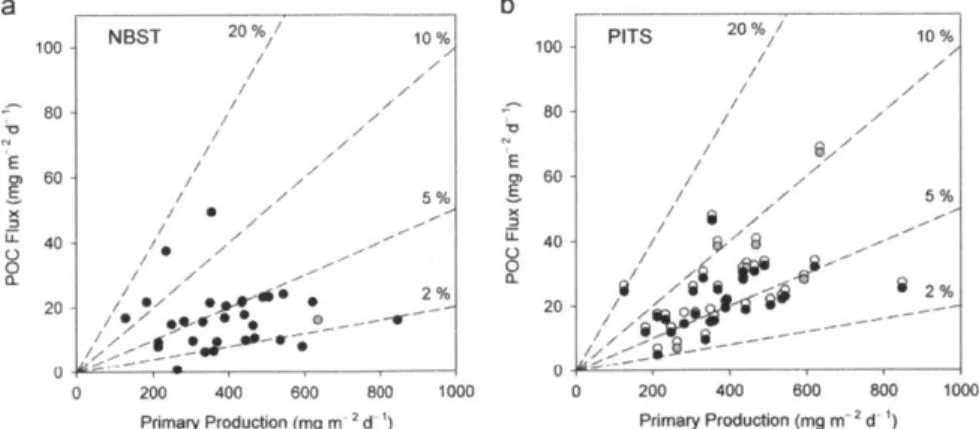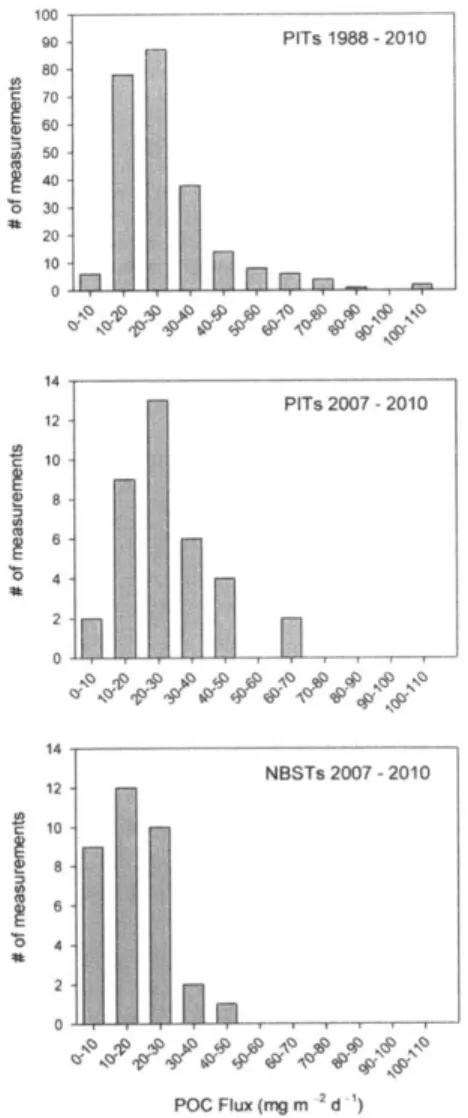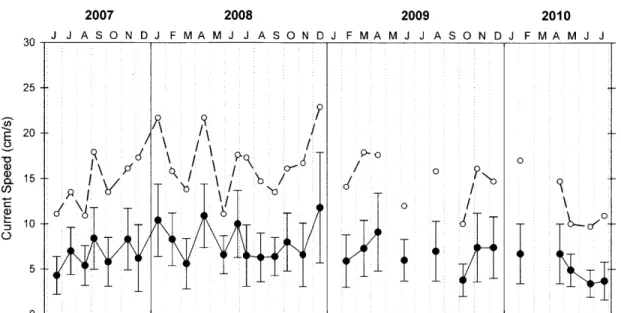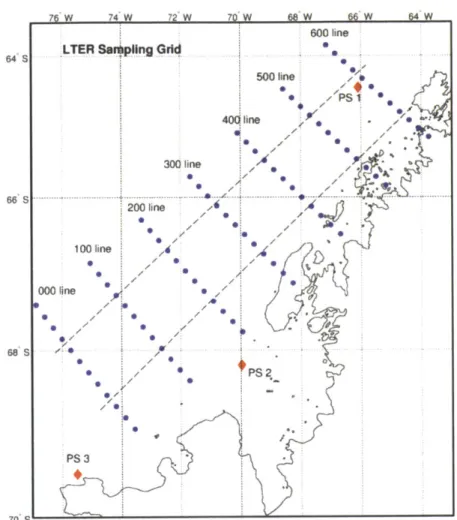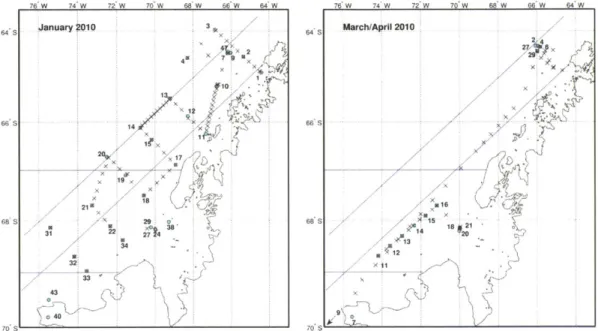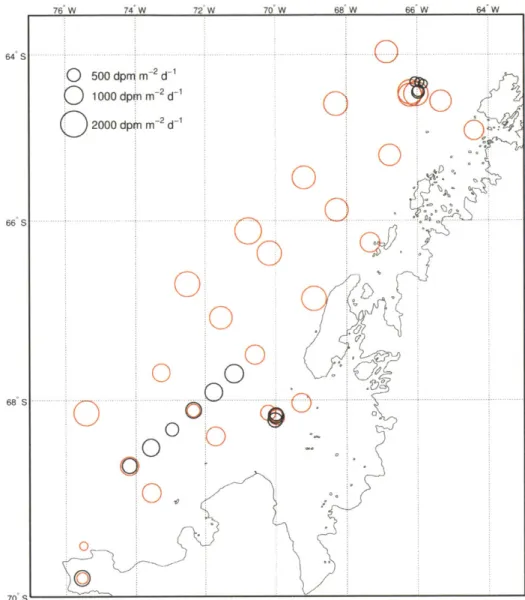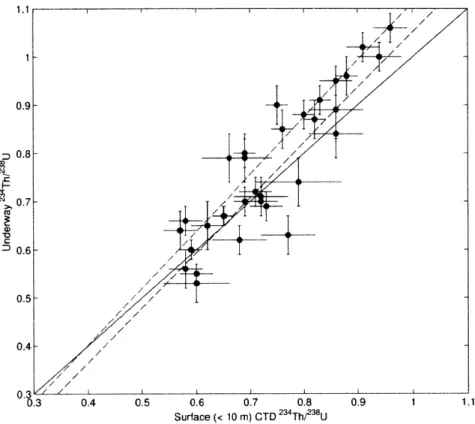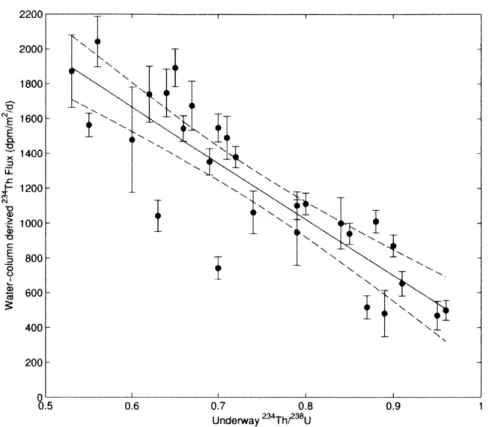Advances in measurements of particle cycling and fluxes in the
By
Stephanie Anne Owens
B.S., Sewanee: The University of the South, 2007
Submitted in partial fulfillment of the requirements for the degree of
Doctor of Philosophy
at the
MASSACHUSETTS INSTITUTE OF TECHNOLOGY
and the
WOODS HOLE OCEANOGRAPHIC INSTITUTION
February 2013
©
2013 Stephanie Anne OwensAll rights reserved.
The author hereby grants to MIT and WHOI permission to reproduce and
to distribute publicly paper and electronic copies of this thesis document
in whole or in part in any medium now known or hereafter created.
Signature of Author
ARCHIVES
ATPITUR
APR
I
Joint Program in Oceanography/Applied
Ocean Science and Engineering
Massachusetts Institute of Technology
and Woods Hole Oceanographic Institution
December 21, 2012
Certified by
r. Ken 0. Buesseler
T-esisSupervisor
Accepted by
Dr. Bernhak eucker-Ehrenbrink
Chair, Joint Committee for Chemical Oceanography
Woods Hole Oceanographic Institution
Advances in measurements of particle cycling and fluxes in the ocean by
Stephanie Anne Owens
Submitted to the Department of Marine Chemistry and Geochemistry, Massachusetts Institute of Technology - Woods Hole Oceanographic Institution
Joint Program in Oceanography/Applied Ocean Science and Engineering on December 21, 2012
in partial fulfillment of the requirements for the degree of Doctor of Philosophy
Abstract
The sinking flux of particles is an important removal mechanism of carbon from the surface ocean as part of the biological pump and can play a role in cycling of other chemical species. This work dealt with improving methods of measuring particle export
and measuring export on different scales to assess its spatial variability. First, the assumption of 2 3 8
U linearity with salinity, used in the 23 8U 234Th method, was reevaluated using a large sample set over a wide salinity range. Next, neutrally buoyant and surface-tethered sediment traps were compared during a three-year time series in the subtropical Atlantic. This study suggested that previously observed imbalances between carbon stocks and fluxes in this region are not due to undersampling by traps. To assess regional variability of particle export, surface and water-column measurements of 2 3 4Th were combined for the first time to measure fluxes on ~20 km scales. Attempts to relate surface properties to particle export were complicated by the temporal decoupling of production and export. Finally, particle export from 234Th was measured on transects of the Atlantic Ocean to evaluate basin-scale export variability. High-resolution sampling through the water-column allowed for the identification of unique 234Th features in the intermediate water column.
Thesis Supervisor: Ken 0. Buesseler
Acknowledgements
I feel so very lucky to have had the opportunity to work with my advisor, Ken
Buesseler. Most graduate students are not required to travel extensively and spend weeks at sea with their advisors, but as an oceanography student, I was fortunate to have Ken as both a mentor and a friend. In addition to the many things Ken has taught me about science, I hope he has also instilled in me his skills of diplomacy that I got to witness for five years as his student. I also blame Ken, but thank him, for developing my interest in politics, particularly as it relates to science. Without his encouragement and support, I might not have had the courage to apply for my Knauss Fellowship. Outside of the office, I have to thank both Ken and his wife, Wendi, for being such good friends to Paul and myself. It was so special to have you be such an integral part of our wedding and I
look to you as role models for our relationship.
My secondary support system was my thesis committee, made up of Phoebe Lam,
Dave Glover, and Mick Follows. Your continued support, suggestions, and
encouragement over the last three years have helped me get to this point. Thank you also, to the chair of my defense, Carl Lamborg, for his support over my time at WHOI. In addition to those mentioned above, through various projects, I have had the
opportunity to work with a large group of scientists whose support and assistance I appreciate including Ken Sims, Matthew Charette, Bill Jenkins, Rachel Stanley, Jim Valdes, Rod Johnson, Mike Lomas, Dave Siegel, Debbie Steinberg, Hugh Ducklow, Hein de Baar, Micha Rijkenberg, and Pere Masque. Those who I may have omitted here have been acknowledged in the relevant thesis chapters.
My time at WHOI would not have been the same without the members of Caf6
Thorium. I owe so much to Steve Pike - my thesis would likely be significantly shorter or at least consist of less data points without Spike. We make a great team on land and at sea and I will sincerely miss seeing him on a daily basis. Andrew McDonnell was my student cohort in the lab for much of my thesis and I have missed him over the last two years. Thankfully, email makes it easy to pester him with my questions now and then. I
look forward to working with Andrew more in the future as we publish our work. Thank you to the other members of Cafe Thorium over the last five years including Kanchan
Maiti, Erin Black. Meg Estapa, Kuanbo Zhou, and Crystal Breier for being great colleagues and friends.
A significant amount of my time in graduate school was spent at sea collecting
samples and data so I must thank the crews of the R/V Atlantic Explorer, R/V Oceanus,
ARSV LM Gould, RVIB NB Palmer, R/V Knorr, and RRS James Cook.
WHOI's Marine Chemistry and Geochemistry department and the MIT-WHOI Joint Program would not run smoothly without the likes of Donna Mortimer, Sheila Clifford, and the Academic Programs staff. Thank you for making this experience possible for all students.
I have made a great number of great friends over the past five years, all of whom
cannot be named here. I must give special thanks however to Carly Buchwald, Erin Bertrand, Abigail Noble, Dan Ohnemus, Maya Yamato, Kim Popendorf, Meredith White, Jeff Kaeli, Meagan Gonnea, and Naomi Levine. Carly Buchwald deserves a special
mention, as my roommate for 3+ years. Thank you for putting up with me for so long and being such a great friend. Regardless if one of us has been at sea or away for several weeks, we can still pick back up where we left off. Yours is a friendship that all others will be stacked against.
My family, including those who aren't with us today, are truly the key to any of
my success. They have constantly believed in and supported me, no questions asked. From deciding to do SEA, to applying to graduate school, and deciding on the MIT-WHOI Joint Program, they have had my back every step of the way. I hope you can realize all that you have done for me. Thank you also to my new family, the
Morrises/Bemands for welcoming me into your fold.
During my time as a student, I was so very fortunate to meet my wonderful and very-recent husband, Paul Morris. While we may never understand the little twists and turns that bring people together, I am so thankful that they turned out the way they did.
Having someone who understands what it means to write and finish a thesis was so helpful. Paul set up the final springboard to get me to the point of completing my thesis, from making sure I had dinner every night to distracting me when I needed a break. Now that it's over, I can't wait to first, go on our honeymoon, and next plan and build our lives together.
Funding support is critical for making the science we do everyday possible and is one of the reasons that I chose to apply for a Knauss Fellowship. I am grateful therefore to the funding sources for my work and me over the last five years. For three years, I was supported by NASA Headquarters under the NASA Earth and Space Science Fellowship Program (Grant NNXI0A072H). Specific projects were funded by grants from the National Science Foundation, including Carbon Flux Through the Twilight Zone - New Tools to Measure Change (OCE-0628416), WAPflux - New Tools to Study the Fates of Phytoplankton Production in the West Antarctic Peninsula (ANT-0838866), and
GEOTRACES Atlantic Section: Trace Element Sources and Sinks Elucidated by
Short-Lived Radium and Thorium Isotopes (OCE-0925158). I received support for books and computers from the MIT Henry G. Houghton Fund and travel support to Bermuda from the MIT Scurlock Fund. Finally, I thank WHOI Academic Programs for their generous supplemental support to the above funding.
Table of Contents
A bstract... 3
A cknow ledgem ents... 5
List of Tables...---.... 9
List of Figures... 10
Chapter 1 Introduction... 13
Chapter 2 Re-evaluating the 28U - salinity relationship in seawater: Implications for the 238U - mTh disequilibrium method... 29
Abstract... 31 2.1 Introduction... 31 2.2 M ethods... 32 2.3 Results... 33 2.4 D iscussion... 35 2.5 Conclusion... 38
Acknow ledgem ents... 39
References... 39
Chapter 3 A new time series of particle export from neutrally buoyant sediment traps at the Bermuda Atlantic Time-series Study site... 41
Abstract... 43
3.1 Introduction... 43
3.2 M ethods... 44
3.3 Results... 45
3.4 Discussion... 48
3.5 Sum m ary & Conclusions... 54
Acknow ledgem ents... 55
Chapter 4 Temporal and spatial variability of particle export off the West Antarctic Peninsula...59 4.1 Introduction... 61 4.2 M ethods... 63 4.3 Results... 68 4.4 Discussion... 73 4.5 Conclusions... 84
A cknow ledgem ents... 85
References... 86
Chapter 5 Thorium-234 as a tracer for particle dynamics in the Atlantic Ocean ... 127
5.1 Introduction... 129
5.2 M ethods... 130
5.3 Results & D iscussion... 134
5.4 Conclusions... 145
A cknow ledgem ents... 147
References... 148
C hapter 6 Conclusions... 175
A ppendix 1 D ata Tables...183
List of Tables
Chapter 2
Table 1: 238U concentration measurements made by ICP-MS... 34
Table 2: Comparison of 2 3 8U results to previous studies... 36
Chapter 3 Table 1: Variability of N BSTs and PITs... 46
Table 2: Blank flux values from this and prior studies for NBSTs and PITs... 48
Chapter 4 Table 1: 2 3 8 U and total 2 34Th versus depth from the West Antarctic Peninsula... 91
Table 2: Key depths, 2 3 4Th fluxes, C/23 4Th ratios, and C fluxes at CTD sites... 101
Table 3: Results of 2 34Th underway sam pling... 103
Table 4: Comparison of sediment trap and water column flux measurements... 106
Chapter 5 Table 1: 234Th and C fluxes on Atlantic GEOTRACES cruises... 153
Table 2: Regional summary of carbon flux estimates... 155
Appendix 1 Table 1: M onthly fluxes from NBSTs at BATS... 184
Table 2: Underway sensor, nutrient, and chlorophyll data from WAP... 186
Table 3: Total 2 34Th profile data from Line W cruise, 2010... 190
List of Figures
Chapter 1
Figure 1: Schematic of the biological carbon pump... 26
Figure 2: Export versus primary production in various ocean regions... 27
Chapter 2 Figure 1: 23 8 U concentrations versus salinity for this and prior studies... 33
Figure 2: Profiles of 238 U at the Bermuda Atlantic Time-series Study site... 37
Figure 3: Profiles of 2 3 4 Th at the Bermuda Atlantic Time-series Study site... 38
Chapter 3 Figure 1: Mass flux, carbon flux, and C:N ratios in NBSTs... 46
Figure 2: Contribution of sinking versus swimmer carbon flux... 47
Figure 3: Results of swimmer removal method comparison... 48
Figure 4: PITs versus NBST POC fluxes from June 2007 to July 2010... 49
Figure 5: PITs and NBST POC fluxes versus time... 49
Figure 6: PITs and NBST POC fluxes versus depth... 50
Figure 7: Results of two-month method and trap inter-comparison experiment... 51
Figure 8: POC flux versus primary production for NBSTs and PITs... 51
Figure 9: Deployment and recovery positions for NBSTs and PITs in 2008... 52
Figure 10: Frequency of low-flux POC measurements in NBSTs and PITs... 53
Figure 11: Export ratios and mineral/POC ratios versus time for NBSTs... 54
Figure Al: 234Th, N, Si, and PIC fluxes in NBSTs... 57
Figure A2: Average and maximum current speeds from PITs array... 58
Figure A3: Weekly sea surface height at BATS during study... 58
Chapter 4 Figure 1: Sampling grid of the Palmer LTER...1 07 Figure 2: Water-column and underway sampling sites... 108
Figure 3: Sample CTD profile with key depths... 109
Figure 4: Summary of 214Th/238U ratios with fluorescence and transmission... 110
Figure 5: 234Th fluxes at PPZ in summer and autumn off the WAP... 111
Figure 6: Underway versus surface bottle measurements of 2 3 4 Th/2 3 8U... 112 Figure 7: 234Th fluxes at PPZ versus underway 234Th/2 3 8 U... 113
234 Figure 8: CTD and underway Th fluxes... 114
Figure 9: C/2 34Th off the W A P ... 15 Figure 10: CTD and underw ay C fluxes... 116
Figure 11: Sedim ent trap results from PSI... 117
Figure 12: Sedim ent trap results from PS2... 118
Figure 13: Sedim ent trap results from PS3... 119
Figure 14: 2 3 4Th profiles with key depths in January 2010... 120
Figure 15: 23 4Th profiles with key depths in March/April 2010... 121
Figure 16: Across shelf C fluxes from CTD and underway measurements... 122
Figure 17: Along shelf C fluxes from CTD and underway measurements... 123
Figure 18: Monthly mean chlorophyll a concentrations from MODIS... 124
Figure 19: Carbon flux measurements versus biological properties... 125
Chapter 5 Figure 1: Map of sampling locations of 234Th on Atlantic GEOTRACES cruises... 156
Figure 2: Total 2 3 4Th profiles of upper 500 m, US GEOTRACES Leg I... 157
Figure 3: Total 2 3 4Th profiles of upper 500 m, US GEOTRACES Leg 2... 158
Figure 4: Total 2 3 4Th profiles of upper 500 m, Dutch GEOTRACES... 159
Figure 5: Summary of 234Th deficits in the Atlantic Ocean... 160
Figure 6: Fluorescence profiles and PPZ depths from US GEOTRACES Leg 1...161
Figure 7: 234Th fluxes at the PPZ in the Atlantic Ocean... 162
Figure 8: Carbon! 34Th ratios in the Atlantic Ocean...163
Figure 9: Carbon234Th ratio compilation for the Atlantic Ocean... 164
Figure 10: Carbon fluxes at the PPZ in the Atlantic Ocean... 165
Figure 11: Comparison of carbon flux estimates to previous studies... 166
Figure 12: Influence of Mediterranean Outflow Water on 2 3 4Th... 167
Figure 13: 2 3 4 Th at the TAG hydrothermal site... 168
Figure 14: Full water column profiles of 2 34Th on US GEOTRACES Leg I... 169
Chapter 1: Introduction
Marine particles and the biological carbon pump
Particulate organic matter (POM) in the ocean, primarily produced during photosynthesis in the sunlit surface, is a key component of many biogeochemical cycles. Most of the POM created in the surface ocean is recycled there and only a small amount escapes as passively sinking particles. This sinking flux of POM alters the distribution of oxygen, nutrients, and trace elements in the ocean (Whitfield and Turner, 1987). In some regions, aeolian supply of dust particles and riverine supply of terrestrial particles can contribute to the pool of sinking particles. Particle-reactive elements can also adsorb onto particle surfaces. Vertical gradients are established in chemical species that are removed from the surface layer of the ocean with POM and then remineralized or redissolved at depth. Although this sinking flux is a small fraction of the total primary production, it is the source of seafloor sediments and an important energy source for
pelagic and benthic life (Honjo, 1996).
Sinking particulate organic carbon (POC) is the primary pathway for removal of carbon from the surface ocean in the biological carbon pump (BCP; Figure 1). Other
removal pathways in the BCP include entrainment of dissolved organic carbon (DOC) below the mixed layer and active transport of POM via vertically migrating zooplankton
(Ducklow et al., 2001). The BCP is a key component of the global carbon cycle because of its ability to isolate carbon from the atmosphere for hundreds to thousands of years.
Without the BCP, it has been predicted that atmospheric carbon dioxide could rise by 200 ppmv (Sarmiento and Toggweiler, 1984). If the POC is remineralized before it reaches the seafloor, it can be stored in the deep ocean as dissolved inorganic carbon (DIC), as long as the water mass is not ventilated to the atmosphere. Of the estimated 5 - 15 GTC
y-1 that leaves the euphotic zone, only about 1% reaches the sediments (Ducklow et al.,
2001). An exception to this is in continental shelf regions, where rates of primary
production and export can be significantly higher (Smith and Hollibaugh, 1993).
The processes that regulate export from the upper ocean, including primary production by phytoplankton, particle aggregation, consumption and egestion by zooplankton, are generally known (Boyd and Trull, 2007). Also known is that the composition and succession of the phytoplankton and zooplankton communities can play an important role in regulating export (Boyd and Newton, 1995; Boyd and Newton,
1999). For example, some species produce dense biominerals that may increase the
sinking rate and thus transport of material out of the euphotic zone. What is less certain is how these processes interact to determine the magnitude and efficiency of the export
by the BCP. The relationship between particle flux and primary production (Figure 2) is
not simple (Buesseler, 1998). One framework used to address the relationship between these two processes is that of new and export production (Dugdale and Goering, 1967;
Eppley and Peterson, 1979). Primary production is driven by "new" and "regenerated" nitrogen where "new" nitrogen is supplied from outside the euphotic via mixing or nitrogen fixation and "regenerated" nitrogen is that which is recycled in the euphotic zone. Over sufficiently large time and space scales, new production should equal the export production (Eppley and Peterson, 1979). When new production is measured, the ratio of new to primary production is termed the "f-ratio." Similarly, when export production is measured the ratio between export and primary production is called the
"e-ratio." This framework has been useful for parameterizing global models of carbon export, particularly by using relationships between the f- and e-ratios and sea surface temperature (Laws et al., 2000; Henson et al., 2011). However, these models do not describe the biological pump mechanistically, as a sum of its component processes. Surface food web/particle export models include production, grazing, and export, however they require detailed geochemical and biological information that is unique to specific regions of the ocean (Michaels and Silver, 1988; Boyd et al., 2008). The largest
limitation to modeling particle export is the lack of observations in both time and space of the contributing processes and resultant flux (Boyd and Trull, 2007).
Methods of measuring particle export
Eppley (1989) outlined four primary methods of measuring new or export
production in the ocean: 1) bottle incubations to measure nutrient uptake, 2) geochemical mass balance of oxygen, carbon dioxide, nutrient, and gas tracers, 3) collection of sinking particles by upper ocean sediment traps, and 4) the 2 38U 2 3 4 Th disequilibrium method. The latter two methods are the ones employed in this work and are the most direct way of measuring export production on small temporal and spatial scales.
Sediment traps are rain gauge-like instruments that capture particles as they settle through the water column. Although conceptually simple, there are several issues associated with sediment trap design and methodology that may bias flux results (Buesseler et al., 2007). The first issue is the hydrodynamic issue, over or
undercollection caused by horizontal flow over the mouth of the trap and trap motion on a mooring line (Gardner, 1985; Gust et al., 1996). Free-drifting, neutrally buoyant
sediment traps that flow with the water in which the particles are sinking have been developed to address this issue (Valdes and Price, 2000; Lampitt et al., 2008). To date however, they have only been used in a limited number of studies, including this work, and have not yet been widely adopted by longer-term sediment trap programs. The second issue is the "swimmer" issue, the inadvertent collection of live zooplankton that are not a true part of the passively sinking flux (Michaels, 1990; Steinberg et al., 1998).
Swimmer carbon can contribute significantly to the total carbon flux collected in the trap, thus the systematic removal of these swimmers is important for accurate determination of carbon flux. Swimmer removal methods include passing samples through mesh screens to segregate swimmers by size, manual picking of the swimmers from samples, and also engineering modifications to the traps. Solubilization, the dissolution of particulate material in the trap after collection, is the third issue. This has been addressed by using brines and poisons to inhibit microbial degradation of particulate material and by limiting the length of deployments and time until sample processing (Lee et al., 1992; Lamborg et al., 2008). Some elements such as phosphorus, however, are subject to significant dissolution, making determination of their export flux difficult (Antia, 2005; Buesseler et al., 2007). Sediment trap types and methodologies vary widely from study to study which can be problematic when trying to compare results. Despite these issues, sediment traps are still the most direct way of sampling the sinking particle flux.
An alternate method for measuring particle flux is the 238U-34 Th disequilibrium method. This method takes advantage of the contrasting properties in seawater and difference in half-lives of this parent-daughter pair to measure export occurring on the
scale of days to months (Bhat et al., 1969; Coale and Bruland, 1985, 1987). 2 3 8U is
highly soluble in seawater and has a long half-life of 4.468 x 109 years. In contrast, 234Th
is very short-lived (t1/2 = 24.1 d) and is highly particle reactive in seawater. As a result of
the large difference in half-lives of this pair, when no 234Th or 2 3 8
U is removed from or
added to the system, the two are in secular equilibrium (Activity of 2 34Th/2 38U
= I).
When 2 3 4
Th is scavenged onto sinking POM in the upper ocean, a deficit of 234Th relative
to 238U is created. By
integrating
overarea
this deficit,a
flux of 234Thcan
be derived.Then, the flux of other species can be determined by multiplying the 2 3 4Th flux by the
elemental: 234
Th ratio on sinking particles (Buesseler et al., 2006). When applied to POC,
the ratio between POC export derived from 234
Th and primary production has been defined as the ThE ratio (Buesseler, 1998). Although this method does not directly capture the sinking flux as sediment traps do, it can be implemented at higher spatial
including resuspension of sediments at the seafloor and hydrothermal plumes (Bacon and
Rutgers van der Loeff, 1989; Kadko et al., 1994; Waples et al., 2006).
Early methods of measuring 23 4Th in seawater required hundreds of liters of seawater, which limited the depth and spatial resolution that could be achieved (Rutgers van der Loeff et al., 2006). In recent years, smaller volume methods that require as little as I L, but typically 4 L (Benitez-Nelson et al., 2001; Buesseler et al., 2001; Pike et al.,
2005), were developed and have since been applied widely (Buesseler et al., 2008a; Buesseler et al., 2008b; Cai et al., 2008; Martin et al., 2011). This method requires knowledge of the 2 3 8U activity in seawater. Measuring 2 3 8U directly can be labor
intensive. Instead, 238U is determined from its conservative or linear relationship with
salinity (Chen et al., 1986; Pates and Muir, 2007). Although this relationship holds over
a large salinity range, deviations have been reported (Delanghe et al., 2002; Robinson et
al., 2004). Thus, care should be taken when applying this technique. A second source of
uncertainty in this method is the determination of appropriate POC/ 2 3 4Th ratios on sinking particles (Buesseler et al., 2006). This ratio is best measured on particles collected by sediment traps or in situ pumps with multiple size-fraction stages. POC/
234Th ratios are known to vary between regions and increase with depth. It is therefore
important that POC/ 2 3 4Th ratios are measured at the depth to which the 2 34Th flux calculations are integrated; a value too shallow would overestimate and a value too deep would underestimate the C flux from the region of particle production.
Sediment traps and 23 4Th can be useful tools when used in combination as they provide complementary information on particle export of a region. Samples from sediment traps can be analyzed for a range of parameters including, but not limited to, carbon, biominerals such as silica and calcium carbonate, and a suite of trace metals. Upper ocean sediment traps are typically deployed for 3 - 5 days and provide information about material sinking across a depth horizon during that deployment period. In contrast,
234
Th sampling can be carried out at higher spatial resolution than can be achieved with sediment traps and integrates over a longer period, up to several weeks, as determined by its half-life. A significant effort has been made to use water-column 23 4Th to determine
the collection efficiency of sediment traps (Knauer et al., 1979; Bacon et al., 1985; Buesseler, 1991). The mismatch of the temporal and spatial scales over which the two methods integrate has made this approach difficult, however. Lagrangian and multi-week
sampling efforts are required to properly calibrate sediment traps (Buesseler, 1994; Buesseler et al., 2008b; Lampitt et al., 2008; Cochran et al., 2009). In addition a calibration factor determined for 2 3 4Th may not be the same as the calibration factor for
other particulate species. Together, however, these two methods can vastly increase our understanding of particle export.
Variability of particle export
One challenge in understanding the relationship between upper ocean processes and particle export is the temporal and spatial variability of the processes that regulate it and of the export itself. The advent of satellite oceanography has allowed us to observe the variability of both physical and biological fields in the surface ocean. Less is known however about variability of export. Models provide the greatest amount of spatial coverage of particle export. Modeling studies based on relationships between export efficiency and temperature, described above, are limited by the number of measurements of new or export production available (Laws et al., 2000; Henson et al., 2011). Inverse models, which use distributions of physical and chemical parameters to derive rates or fluxes, integrate over the history of a water mass and thus average over large spatial
scales (Schlitzer, 2002; Usbeck et al., 2003; Schlitzer, 2004). These model studies do,
however, highlight the basin-scale variability of particle export.
Field-studies and models have investigated the small-scale variability of
phytoplankton and zooplankton (Mackas and Boyd, 1979; Yoder et al., 1993; Abraham,
1998; Gargon et al., 2001; Mahadevan and Campbell, 2002; Martin, 2003; Levy and
Klein, 2004). Generally heterogeneity is higher in zooplankton relative to phytoplankton, which are more heterogeneous than the physical parameters such as temperature and
salinity. As export flux is a product of complex interactions between mixing,
similar scale to phytoplankton or smaller. Results from studies using 234Th and
underwater cameras have hinted at this smaller scale variability of export (Guidi et al.,
2007; Buesseler et al., 2008b; Guidi et al., 2008). A recent study modeling export flux
and measurements of 23 4
Th has demonstrated the heterogeneity of export on scales of 100 km and less (Resplandy et al., 2012). There are few measurements of export flux on these scales, however. Another factor to consider is that spatial variability of export could lead to misinterpretation of results when only a few measurements by sediment traps or
234Th are made within a specific region (Resplandy et al., 2012).
Particle export can vary on seasonal and interannual scales as a result of physical, nutrient, phytoplankton, and zooplankton variability on these scales. For example, off the Western Antarctic Peninsula, daily export rates vary over four orders of magnitude during the year due to changes in water column stratification and nutrient supply
(Ducklow et al., 2008). This range of variability is also observed interannually. In other regions pulses of export may occur as a result of episodic events like delivery of dust to the surface ocean, supply of nutrients to the surface by eddies, or salp blooms. Particle
flux can also be temporally separated or lag biogeochemical changes in the euphotic zone. This can preclude drawing simple relationships between euphotic zone properties
and export when both are measured simultaneously. Time-series studies are invaluable for overcoming these obstacles to understanding particle flux and its controlling
properties (Boyd and Trull, 2007; Ducklow et al., 2009).
This thesis
This work includes four independent chapters on aspects of particle export and cycling and a concluding chapter summarizing the overall results and discussing recommendations for future avenues of research. Chapters 2 and 3 address
improvements in methods to measure particle export while Chapters 4 and 5 present results from studies investigating the variability of export on regional and basin scales. The overarching aim of this work is to advance the methods used to measure export and
how they are applied in order to increase our understanding of export production by the BCP.
In Chapter 2, the linear relationship between 238U and salinity is reassessed using
high precision mass spectrometry techniques. The impetus for this work was the
observation of anomalous deficits of 2 3 4
Th at depths of~800 m in the subtropical North
Atlantic. 238U was analyzed to determine whether these features were due to changes in
238U or 234Th. Chapter 3 presents the first time-series of particle flux measured using
neutrally buoyant sediment traps. These traps were deployed concurrently with
traditional, surface-tethered traps at the Bermuda Atlantic Time-series Study (BATS) site. In addition to comparing fluxes collected by these contrasting sediment trap models, methods of sample processing were also rigorously examined.
In Chapter 4, the results of a survey of particle export off the Western Antarctic
Peninsula are reported. Water-column 234
Th and sediment traps were used to evaluate
along and across shelf trends in particle flux. In addition, surface samples of 23 4Th were
collected every 10 to 20 km over a large region of the Peninsula to assess smaller scale variability of export. Repeat sampling in the summer and autumn allowed for the
observation of seasonal changes in export in this region. Finally, in Chapter 5, two
transects of the Atlantic Ocean are used to observe large-scale variability in export.
These extensive surveys also included high depth resolution measurements of 234Th,
which are discussed further in the context of particle cycling at ocean boundaries, including continental shelves, the seafloor, and hydrothermal vents.
References
Abraham, E.R., 1998. The generation of plankton patchiness by turbulent stirring. Nature
391, 577-580.
Antia, A.N., 2005. Particle-associated dissolved elemental fluxes, revising the stoichiometry of mixed layer export. Biogeosciences Discussions 2, 275-302.
Bacon, M.P., Huh, C.A., Fleer, A.P., Deuser, W.G., 1985. Seasonality in the flux of
natural radionuclides and plutonium in the deep Sargasso Sea. Deep Sea Research
32, 273-286.
Bacon, M.P., Rutgers van der Loeff, M.M., 1989. Removal of thorium-234 by scavenging in the bottom nepheloid layer of the ocean. Earth and Planetary
Science Letters 92 (2), 157-164.
Benitez-Nelson, C.R., Buesseler, K.O., van der Loeff, M.R., Andrews, J., Ball, L., Crossin, G., Charette, M.A., 2001. Testing a new small-volume technique for
234
determining 4Th in seawater. Journal of Radioanalytical and Nuclear Chemistry
248 (3), 795-799.
Bhat, S.G., Krishnaswamy, S., Lal, D., Rama, Moore, W.S., 1969. 2 3 4Th/238U ratios in the ocean. Earth and Planetary Science Letters 5, 483-491.
Boyd, P., Newton, P., 1995. Evidence of the Potential Influence of Planktonic Community Structure on the Interannual Variability of Particulate
Organic-Carbon Flux. Deep-Sea Research 1 42 (5), 619-639.
Boyd, P.W., Gall, M.P., Silver, M.W., Coale, S.L., Bidigare, R.R., Bishop, J.K.B., 2008.
Quantifying the surface-subsurface biogeochemical coupling during the
VERTIGO ALOHA and K2 studies. Deep-Sea Research II 55, 1578-1593.
Boyd, P.W., Newton, P.P., 1999. Does planktonic community structure determine downward particulate organic carbon flux in different oceanic provinces?
Deep-Sea Research I 46 (1), 63-91.
Boyd, P.W., Trull, T.W., 2007. Understanding the export of biogenic particles in oceanic waters: Is there consensus? Progress in Oceanography 72 (4), 276-312.
Buesseler, K.O., 1991. Do upper-ocean sediment traps provide an accurate record of
particle flux? Nature 353, 420-423.
Buesseler, K.O., 1998. The decoupling of production and particulate export in the surface
ocean. Global Biogeochemical Cycles 12 (2), 297-310.
Buesseler, K.O., Antia, A.N., Chen, M., Fowler, S.W., Gardner, W.D., Gustafsson, 0., Harada, K., Michaels, A.F., van der Loeffo, M.R., Sarin, M., Steinberg, D.K., Trull, T., 2007. An assessment of the use of sediment traps for estimating upper ocean particle fluxes. Journal of Marine Research 65 (3), 345-416.
Buesseler, K.O., Benitez-Nelson, C.R., Moran, S.B., Burd, A., Charette, M., Cochran,
J.K., Coppola, L., Fisher, N.S., Fowler, S.W., Gardner, W., Guo, L.D.,
Gustafsson, 0., Lamborg, C., Masque, P., Miquel, J.C., Passow, U., Santschi, P.H., Savoye, N., Stewart, G., Trull, T., 2006. An assessment of particulate organic carbon to thorium-234 ratios in the ocean and their impact on the
Buesseler, K.O., Benitez-Nelson, C.R., Rutgers van der Loeff, M., Andrews, J., Ball, L., Crossin, G., Charette, M.A., 2001. An intercomparison of small- and large-volume techniques for thorium-234 in seawater. Marine Chemistry 74 (1), 15-28. Buesseler, K.O., Lamborg, C., Cai, P., Escoube, R., Johnson, R., Pike, S., Masque, P.,
McGillicuddy, D., Verdeny, E., 2008a. Particle fluxes associated with mesoscale
eddies in the Sargasso Sea. Deep-Sea Research II 55 (10-13), 1426-1444. Buesseler, K.O., Michaels, A.F., Siegel, D.A., Knap, A.H., 1994. A three dimensional
time-dependent approach to calibrating sediment trap fluxes. Global
Biogeochemical Cycles 8 (2), 179-193.
Buesseler, K.O., Pike, S., Maiti, K., Lamborg, C.H., Siegel, D.A., Trull, T.W., 2008b.
Thorium-234 as a tracer of spatial, temporal and vertical variability in particle flux in the North Pacific. Deep-Sea Research Part I-Oceanographic Research
Papers 56 (7), 1143-1167.
Cai, P., Chen, W., Dai, M., Wan, Z., Wang, D., Li,
Q.,
Tang, T., Lv, D., 2008. Ahigh-resolution study of particle export in the southern South China Sea based on
Th-234/U-238 disequilibrium. Journal of Geophysical Research 113.
Chen, J.H., Edwards, R.L., Wasserburg, G.J., 1986. 238U, 234U and 2m2Th in seawater. Earth and Planetary Science Letters 80 (3-4), 241-251.
Coale, K.H., Bruland, K.W., 1985. 234
Th:23 8
U disequilibria within the California Current.
Limnology and Oceanography 30 (1), 22-33.
Coale, K.H., Bruland, K.W., 1987. Oceanic stratified euphotic zone as elucidated by
234Th:238U disequilibria. Limnology and Oceanography 32 (1), 189-200.
Cochran, J.K., Miquel, J.C., Armstrong, R., Fowler, S.W., Masque, P., Gasser, B., Hirschberg, D., Szlosek, J., Rodriguez y Baena, A.M., Verdeny, E., Stewart, G.,
2009. Time-series measurements of Th-234 in water column and sediment trap
samples from the northwestern Mediterranean Sea. Deep-Sea Research II 56 (18),
1487-1501.
Delanghe, D., Bard, E., Hamelin, B., 2002. New TIMS constraints on the uranium-238 and uranium-234 in seawaters from the main ocean basins and the Mediterranean
Sea. Marine Chemistry 80 (1), 79-93.
Ducklow, H.W., Doney, S.C., Steinberg, D.K., 2009. Contributions of Long-Term Research and Time-Series Observations to Marine Ecology and Biogeochemistry. Annual Review of Marine Science 1, 279-302.
Ducklow, H.W., Erickson, M., Kelly, J., Montes-Hugo, M., Ribic, C.A., Smith, R.C.,
Stammerjohn, S.E., Karl, D.M., 2008. Particle export from the upper ocean over the continental shelf of the west Antarctic Peninsula: A long-term record,
1992-2007. Deep-Sea Research II 55, 2118-2131.
Ducklow, H.W., Steinberg, D.K., Buesseler, K.O., 2001. Upper Ocean Carbon Export
and the Biological Pump. Oceanography 14 (4), 50-58.
Dugdale, R.C., Goering, J.J., 1967. Uptake of new and regenerated forms of nitrogen in
primary productivity. Limnology and Oceanography 12 (2), 196-206.
Eppley, R.W., 1989. New production: history, methods, and problems. In: Berger, W.H., Smetacek, V.S., Wefer, G. (Eds.), Productivity of the Ocean: Present and Past.
Eppley, R.W., Peterson, B.J., 1979. Particulate organic matter flux and planktonic new
production in the deep ocean. Nature 282 (5740), 677-680.
Gargon, V.C., Oschlies, A., Doney, S.C., McGillicuddy Jr., D.J., Waniek, J., 2001. The
role of mesoscale variability on plankton dynamics in the North Atlantic.
Deep-Sea Research II 48, 2199-2226.
Gardner, W.D., 1985. The effect of tilt on sediment trap efficiency. Deep Sea Research
32, 349-361.
Guidi, L., Jackson, G.A., Stemmann, L., Miquel, J.C., Picheral, M., Gorsky, G., 2008.
Relationship between particle size distribution and flux in the mesopelagic zone.
Deep-Sea Research I 55 (1364-1374).
Guidi, L., Stemmann, L., Legendre, L., Picheral, M., Prieur, L., Gorsky, G., 2007.
Vertical distribution of aggregrates (>110 pm) and mesoscale activity in the northeastern Atlantic: Effects on the deep vertical export of surface carbon.
Limnology & Oceanography 52, 7-18.
Gust, G., Bowles, W., Giordano, S., Huettel, M., 1996. Particle accumulation in a cylindrical sediment trap under laminar and turbulent steady flow, An experimental approach. Aquatic Sciences 58, 297-326.
Henson, S.A., Sanders, R., Madsen, E., Morris, P.J., Le Moigne, F., Quartly, G.D., 2011.
A reduced estimate of the strength of the ocean's biological carbon pump.
Geophysical Research Letters 38 (L04606).
Honjo, S., 1996. Fluxes of Particles to the Interior of the Open Oceans. In: Ittekkot, V., Schafer, P., Honjo, S., Depetris, P.J. (Eds.), Particle Flux in the Ocean. John
Wiley & Sons, New York, pp. 91-154.
Kadko, D., Feely, R., Massoth, G., 1994. Scavenging of Th-234 and phosphorus removal
from the hydrothermal effluent plume over the North Cleft segment of the Juan de
Fuca Ridge. Journal of Geophysical Research 99, 5017-5024.
Knauer, G.A., Martin, J.H., Bruland, K.W., 1979. Fluxes of particulate carbon, nitrogen, and phosphorus in the upper water column of the northeast Pacific. Deep-Sea
Research 26 (1), 97-108.
Lamborg, C.H., Buesseler, K.O., Valdes, J., Bertrand, C.H., Bidigare, R., Manganini, S.,
Pike, S., Steinberg, D., Trull, T., Wilson, S., 2008. The flux of bio- and lithogenic
material associated with sinking particles in the mesopelagic "twilight zone" of the northwest and North Central Pacific Ocean. Deep-Sea Research Part
Ii-Topical Studies in Oceanography 55 (14-15), 1540-1563.
Lampitt, R.S., Boorman, B., Brown, L., Lucas, M., Salter, I., Sanders, R., Saw, K., Seeyave, S., Thomalla, S.J., Turnewitsch, R., 2008. Particle export from the euphotic zone: Estimates using a novel drifting sediment trap, Th-234 and new production. Deep-Sea Research Part I-Oceanographic Research Papers 55 (11),
1484-1502.
Laws, E.A., Falkowski, P.G., Smith, W.O., Ducklow, H., McCarthy, J.J., 2000.
Temperature effects on export production in the open ocean. Global
Lee, C., Hedges, J.I., Wakeham, S.G., Zhu, N., 1992. Effectiveness of various treatments in retarding microbial activity in sediment trap material and their effects on the collection of swimmers. Limnology & Oceanography 37 (1), 117-130.
Levy, M., Klein, P., 2004. Does the low frequency of the mesoscale dynamics explain a part of the phytoplankton and zooplankton spectral variability? Proceedings of the
Royal Society of London A 460, 1673-1687.
Mackas, D.L., Boyd, C.M., 1979. Spectral analysis of zooplankton spatial heterogeneity.
Science 204, 62-64.
Mahadevan, A., Campbell, J., 2002. Biogeochemical patchiness at the sea surface.
Geophysical Research Letters 29 (19), 1926.
Martin, A.P., 2003. Phytoplankton patchines: the role of lateral stirring and mixing.
Progress in Oceanography 57, 125-174.
Martin, P., Lampitt, R.S., Perry, M.J., Sanders, R., Lee, C., D'Asaro, E., 2011. Export and mesopelagic particle flux during a North Atlantic spring diatom bloom. Deep-Sea
Research I 58, 338-349.
Michaels, A.F., Silver, M.W., 1988. Primary production, sinking fluxes, and the
microbial food web. Deep Sea Research 35, 473-490.
Michaels, A.F., Silver, M.W., Gowing, M.M., Knauer, G.A., 1990. Cryptic zooplankton
"swimmers" in upper ocean sediment traps. Deep-Sea Research 1 37 (8A),
1285-1296.
Pates, J.M., Muir, G.K.P., 2007. U-salinity relationships in the Mediterranean:
Implications for Th-234/U-238 particle flux studies. Marine Chemistry 106, 530-545.
Pike, S.M., Buesseler, K.O., Andrews, J., Savoye, N., 2005. Quantification of 2 3 4
Th recovery in small volume sea water samples by inductively coupled plasma mass spectrometry. Journal of Radioanalytical and Nuclear Chemistry 263 (2),
355-360.
Resplandy, L., Martin, A.P., Le Moigne, F., Martin, P., Aquilina, A., Mmery, M., Levy,
M., Sanders, R., 2012. How does dynamical spatial variability impact Th-234
derived estimates of organic export? Deep-Sea Research I.
Robinson, L.F., Belshaw, N.S., Henderson, G.M., 2004. U and Th concentrations and isotope ratios in modern carbonates and waters from the Bahamas. Geochimica et
Cosmochimica Acta 68 (8), 1777-1789.
Rutgers van der Loeff, M., Sarin, M.M., Baskaran, M., Benitez-Nelson, C., Buesseler, K.O., Charette, M., Dai, M., Gustafsson, 0., Masque, P., Morris, P.J., Orlandini, K., Baena, A.R.Y., Savoye, N., Schmidt, S., Turnewitsch, R., Voge, I., Waples,
J.T., 2006. A review of present techniques and methodological advances in
analyzing 2 3 4
Th in aquatic systems. Marine Chemistry 100 (3-4), 190-212. Sarmiento, J.L., Toggweiler, J.R., 1984. A new model for the role of the oceans in
determining atmospheric pCO2. Nature 308, 620-624.
Schlitzer, R., 2002. Carbon export fluxes in the Southern Ocean: results from inverse modeling and comparison with satellite-based estimates. Deep-Sea Research II 49
Schlitzer, R., 2004. Export production in the equatorial and North Pacific derived from dissolved oxygen, nutrient and carbon data. Journal of Oceanography 60 (1),
53-62.
Smith, S.V., Hollibaugh, J.T., 1993. Coastal Metabolism and the Oceanic Organic-Carbon Balance. Reviews of Geophysics 31 (1), 75-89.
Steinberg, D.K., Pilskaln, C.H., Silver, M.W., 1998. Contribution of zooplankton
associated with detritus to sediment trap "swimmer" carbon in Monterey Bay,
CA. Marine Ecology Progress Series 164, 157-166.
Usbeck, R., Schlitzer, R., Fischer, G., Wefer, G., 2003. Particle fluxes in the ocean: comparison of sediment trap data with results from inverse modeling. Journal of
Marine Systems 39 (3-4), 167-183.
Valdes, J.R., Price, J.F., 2000. A neutrally buoyant, upper ocean sediment trap. Journal of
Atmospheric and Oceanic Technology 17 (1), 62-68.
Waples, J.T., Benitez-Nelson, C., Savoye, N., Rutgers van der Loeff, M., Baskaran, M., Gustafsson, 0., 2006. An introduction to the application and future use of 234Th in
aquatic systems. Marine Chemistry 100 (3-4), 166-189.
Whitfield, M., Turner, D.R., 1987. The role of particles in regulating the composition of seawater. Aquatic Surface Chemistry: Chemical Processes at the Particle-Water
Interface. John Wiley and Sons, New York, NY, pp. 457-493.
Yoder, J.A., Aiken, J., Swift, R.N., Hoge, F.E., Stegmann, P.M., 1993. Spatial variability
in near-surface chlorophyll a fluorescence measured by airborne oceanographic
Figure 1 Schematic of surface ocean processes that compose the ocean's biological carbon pump. Phytoplankton take up carbon dioxide and nutrients in the sunlit region to create dissolved (DOM) and particulate organic matter (POM). A fraction of the organic matter produced becomes isolated below this layer by passive sinking of particles, downward mixing of DOM, or active transport by zooplankton. Within this surface layer and below it, POM can aggregate, be grazed, or remineralized. (Reproduced with
70 60 1 50 *40 20 10 0 0 20 40 60 80 100 120 140
Primary Production (mmol C m-
2d)
0
Equatorial Pacifico High Latitudes
* Subtropical Atlantic A Arabian Sea
* North Atlantic
Figure 2 Carbon flux versus primary production measurements from the equatorial
Pacific, subtropical Atlantic, Arabian Sea, the Arctic and Southern Ocean, and the north Atlantic. Ratios between export and primary production vary widely within and between oceanic regions. Reproduced from Buesseler, 1998.
Chapter 2:
Re-evaluating the
23 8U
-
salinity relationship in seawater: Implications
for the
238U -2'Th disequilibrium method
This chapter was originally published in Marine Chemistry by Elsevier and is reproduced here with their permission.
Re-evaluating the 238U - salinity relationship in seawater: Implications for the 238U
-23 4Th disequilibrium method. Marine Chemistry. S.A. Owens, K.O. Buesseler, K.W.W.
Marine Chemistry 127 (2011) 31-39
Contents lIsis available at ScienceDirect
Marine Chemistry
journal homepage: www.elsevier.com/locate/marchem
Re-evaluating the
238U-salinity relationship in seawater: Implications for the
2 3 8 U_ 2 3 4
Th disequilibrium method
S.A. Owens a,b,*, KO. Buesseler , KW.W. Sims c
Department of Marine Chemistry and Geochemistry MS#25, Woods Hole Oceanographic Insttution. 266 Woods Hole Road, Woods Hole, MA 02543, USA MIT-WHO! Joint Program in Oceanography/Applied Ocean Science Engineering, 266 Woods Hole Road, Woods Hole, MA 02543, USA
Department of Geology and Geophysics, University of Wyoming, Dept 3006, Laramie, WY 82071, USA
ARTICLE INFO Article history:
Received 23 May 2011
Received in revised form 13 July 2011 Accepted 14 July 2011 Available online xxxx Keywords: Uranium Salinity Thorium Particle export ABSTRACT
The concentration of 238U in seawater is an important parameter required for applications of uranium
decay-series radionuclides used to understand particle export and cycling in marine environments. Using modem
mass spectrometer techniques, we re-evaluated the relationship between "U and salinity in the open ocean.
The new 238U-salinity relationship determined here is based on a larger sample set and a wider salinity range
than previous work in the open ocean. Four samples from 500 to 1000 m in the subtropical Atlantic deviated
significantly from their concentration predicted from salinity; these low concentrations are hypothesized to
be the result of a remote removal process rather than analytical bias or local removal of uranium. We also bring attention to unique deficits of 2 34fh in the mesopelagic zone of the subtropical Atlantic and encourage future applications of 23*M to delve into the cause of these features. Determining the concentration of 18U in the open ocean is critical for minimizing uncertainty in the
sagU_2h
disequilibrium method, which is a key tool for understanding particle flux to the deep ocean.@ 2011 Elsevier B.V. All rights reserved.
1. Introduction
The marine geochemistry of uranium has been studied for several decades beginning with measurements of its speciation and distribution in the ocean (Ku et aL, 1977) and expanding to studies of its daughter isotopes for tracers of past and present marine processes (Cochran,
1992). Measurements of uranium by alpha spectroscopy were some of
the earliest to report conservative behavior of uranium with respect to salinity in the open ocean (Kuet al, 1977). A linear relationship between salinity and uranium concentration could only be established for the Antarctic and Arctic Oceans, due to the narrow range of salinities of the samples analyzed however. Later work used mass spectrometric techniques to perform similar measurements in the Atlantic and Pacific Oceans (Chen et at, 1986; Chen and Wasserburg, 1981). The relationship established by Chen et aL (1986) is still the most widely referenced value for determining uranium concentrations in seawater from salinity.
Despite the widespread use of the Chen et al (1986) relationship, non-conservative behavior or deviations from this relationship have been reported in the open ocean. In a study of the Atlantic Ocean. it was hypothesized that low uranium-238 concentrations relative to salinity were due to the influence of Mediterranean Outflow Water (MOW) (Delanghe et al., 2002) but later work found no evidence to support this hypothesis (Schmidt, 2006). In another notable instance,
Corresponding author. TeL: +1 508 289 3843: fax: +1 508 457 2193.
E-mail addresses: sowens@whoi.edu (SA Owens), kbuesseler@whoi.edu (KO. Buesseler), ksims7@uwyo.edu (K..w. Sims).
0304-4203/S -see front matter Q 2011 Elsevier B.v All rights reserved. doi:10.3016fj.marchem.2011.07.005
Robinson et al (2004) measured higher values of 23SU in the Bahamas
than predicted from salinity. In a review of 234h methodology,
Rutgers van der Loeff et aL (2006) compiled ocean 238U data and described possible causes of deviations from conservative behavior particularly sedimentary and estuarine addition and removal pro-cesses. Most recently, work in the Mediterranean Sea revealed higher
23BU concentrations than predicted from salinity (Pates and Muir,
2007). Pates & Muir (2007) hypothesized that deviation from the
Chen et aL relationship may be significant in the Mediterranean Sea due to its large river inputs and its restricted exchange with the open ocean. They proposed a revised 2SU-salinity relationship, which combined previously published mass spectrometry data with their own, although they were not able to rule out analytical bias as a cause of variability between the studies. The resulting relationship between
23U and salinity was not significantly different from that of Chen et al.
however it resulted in a larger uncertainty than previously published (Pates and Muir, 2007).
The Chen et aL (1986) uranium-salinity relationship is frequently utilized in the 23SU-M*h disequilibrium method, which is used to quantify particulate export flux and elucidate particle dynamics. This method takes advantage ofthe contrasting chemical behaviorof uranium and thorium inseawater(Bacon etal., 1996; Bhatet at, 1969; Buesseler et al, 1992). At pH values and CO2 concentrations typical of oxic seawater,
the predominant uranium species, U(VI), is highly soluble and occurs as a stable carbonate ion complex, U02(C3)f (Djogic et aL, 1986). In
contrastTh(IV), the stable ion of thorium under oxic conditions, is highly particle reactive (Santschi et al, 2006). The 4A7 x 109 y half-life of 23sU
SA Owens et aL / Marine Chemistry 127 (2071) 31-39
Uaffey et aL, 1971) greatly exceeds the 24.1 day half-life of its daughter, 1*Th. Due to the large difference in the half-lives of this parent-daughter nuclide pair, when there are no external forces adding or removing either of the two isotopes from the system, 38U and 2Th achieve a state of secular equilibrium after 5 to 6 half-lives of 23 4fh. At secular equilibrium, the activity of 2*fh is equal to the activity of 23U. In the surface ocean, a deficit of 234Th activity (relative to 238U) occurs when 23Th sorbs to particulate matter and is removed as that material sinks. An excess of 2
*fh can occur when dissolution or remineralization of sinking particles occurs, releasing 234Th into solution deeper in the water column. This approach requires knowledge of the activity of both -3*Fh and 23U in seawater and the uraniun-salinity relationship is a convenient means of estimating 23U activity. Quantifying the uncertainty in the 238U-salinity
relationship can also be important for minimizing uncertainty in estimates of z3*fh flux. As illustrated in Fig. 6 of Pates & Muir (2007), a 1% difference in uncertainty of 23U measurements can result in up to a 5% difference in 23fh flux uncertainty.
Motivation for this work stemmed from observations of 23Th during the Eddy Dynamic Mixing Export, and Species (EDDIES) program in the Sargasso Sea, which studied the effect of eddy-induced changes on biogeochemical cycling (Buesseler et al., 2008a; McGillicuddy Jr. et al., 2007). Typically, deficits of 23Th are constrained to the euphotic zone as a result of marine particle formation through primary production and subsequent removal by passive sinking of the particles (Bacon et aL, 1996; Buesseler et al., 2008a, 2008b). In EDDIES however, at least three
profiles of 23Th were collected showing a
a'Th
deficit relative to 28U between 500 and 1000 m defined by at least three individual samples in each case. Thisa3Th
deficit tended to be co-located with the local oxygen minimum zone. This feature could be due to anomalous 23U8 behavior at these depths or a particle repackaging process that was reflected in the m34Th profile. Unfortunately, no samples for 238U were collected during the EDDIES program. In other studies of m34Th, similar features have been observed in one or two samples from intermediate depths however, because of its utility as a measure of export flux, most studies focus sampling efforts on the euphotic zone, providing limited depth resolution through the mesopelagic (Benitez-Nelson et al., 2001 a; Coppola et aL, 2005; Schmidt, 2006). In this work, we attempt to capture these unique 23Th features with paired measurements of 2"U and3Th and increased sampling resolution through the mesopelagic zone to highlight unique and previously undescribed behavior of both 23U and 237h at these depths. Finally we propose an alternate 238U-salinity relationship developed from a large set of 11U measurements that encompasses a wide range of salinity values and was obtained using sensitive mass spectrometric techniques.
2. Methods
2.1, Study sites
Samples were collected on three cruises to the Bermuda Atlantic Time-series Study site (BATS) on the R/VAtlantic Explorer in July 2007, June 2008, and September 2009, a cruise (SIRENA) across the tropical Atlantic on the RN Oceanus in August 2009, and on three cruises to the Southern Ocean on the ARSV Laurence M. Gould in January 2009 and 2010 and on the RVIB Nathaniel B. Palmer in March 2010. Salinity values for the Southern Ocean samples were taken from CID sensors. which were calibrated on an annual basis and exhibit an insignificant amount of drift between calibrations (e.g. + 0.00010 psu month-'). Salinity values for samples from the BATS site and the tropical Atlantic were made using a salinometer either on land or at sea.
2.2. 236U Sampling and concentration measurements
Collection vials for 23U were prepared by washing them in a 10% HCl solution followed by 5% HNO3 solution, rinsing with ultra-clean water (18.2 M11) before and after each step. The vials were rinsed
with the sample water three times before filling and were then sealed with Parafilm* to prevent evaporation. Samples were stored in a dark,
room-temperature environment until preparation for analysis. 28U concentrations were determined by isotope dilution (ID) using a Thermo Scientific ELEMENT 2 Inductively Coupled Plasma Mass Spectrometer (ICP-MS). Teflon* vials were used throughout sample preparation and were subjected to rigorous cleaning including soaking and boiling in 50% HCL soaking in aqua regia (1:3 HNO3 and HCI), soaking and boiling in 50% HNO3, and a final boil in weakly acidifed (HNO3)water, with generous rinses of ultra-clean water between each step. Sample aliquots of 5 mLwere spiked with a well-calibrated 33
U spike to achieve 2iU/23U: 10; the collection vial, the spike bottle, and the Teflon vial into which the sample and spike were aliquoted, were weighed when sample or spike was removed or added in order to precisely determine the mass of sample and spike in each analysis aliquot. Samples were equilibrated and digested over the course of two days. First, samples were allowed to evaporate overnight at 75 'C in a laminar flow bench. After cooling, 1 mL concentrated HNO3 was added to each sample, which was then capped and returned to the hot-plate for 15 min. Then I mL of Milli-Q water was added to each sample and samples were capped and left to sit overnight at room temperature to allow complete equilibration and digestion. Uranium was purified and separated from salts using anion exchange columns. Eichrom 2 mL acid-cleaned columns were prepared using 1 mL of pre-conditioned (50% HCI and dilute HNO3 with Milli-Q rinses) Eichrom AG1 x 8 anion exchange resin. Each column was further conditioned with Milli-Q 10 M HCL I M HQ, Milli-Q and 7 M HNO3. The dissolved samples (-7 M HNO3) were loaded onto the columns and the sample dissolution vials were carefully rinsed with additional 7 M HNO3. To collect uranium, the columns were eluted with Milli-Q 1 M HG. and I M HBr. Samples were dried overnight at a low temperature and then sample vials were stored in bags until analysis.
Immediately prior to analysis, samples were brought up in I ml. of 5% HNO3 and quickly measured in analog mode. Based on the initial intensity of the major isotope, 23U, the samples were then diluted such that all isotopes of U were measured in ion counting mode. The instrument was tuned using the NBS-960 standard to achieve flat peak tops and stable signal intensity. Mass fractionation corrections were made by bracketing samples with the NBS-960 standard (28U/235U= 137.88) and using the linear average to correct the measured 2"U/235U (0.04 - 2.76% correc-tion) and 2SU/23U (0.07 -4.55% correction) ratios. Similarly, samples were blank corrected using bracketed blank acid samples. Background signals of zU and 23U were less than 0.50% of the spike and sample signals. Prior to data collection, the in-growth of the NBS-960 or sample signal was observed until it appeared stable, at which point data collection was initiated. Each sample was analyzed in triplicate, so that each reported value is the average of these individual measurements. The propagated error includes the standard deviation of these three measurements, the uncertainty associated with weighing the sample and spike, and the uncertainty on the 33
U spike calibration. The measurement sequene for a single sample was: blank-NBS-960-blank-sample-sample-sample-blank-NBS960 and so forth. Samples of the International Association for Physical Sciences of the Ocean (IAPSO) Standard Seawater (OSIL P149) were analyzed to assess the reproduc-ibility of the measurements over multiple mins on the ICP-MS and to establish a laboratory standard for future studies of "U in seawater. The calibration of our 233U spike has also been verified in several studies using equilibrium rock standards (Sims et al., 2008).
23. "A sampling and analysis
'3Th was determined using the 4 L method of co-precipitating "*lh
with MnO2 and beta counting the samples on low background, coincidence detectors (Rise National laboratories) either on land or at sea as soon as possible after collection (Benitez-Nelson et aL, 2001b; Buesseler et al, 2001). Detector efficiency and background were determined at regular intervals over the period of this study. Final 32
